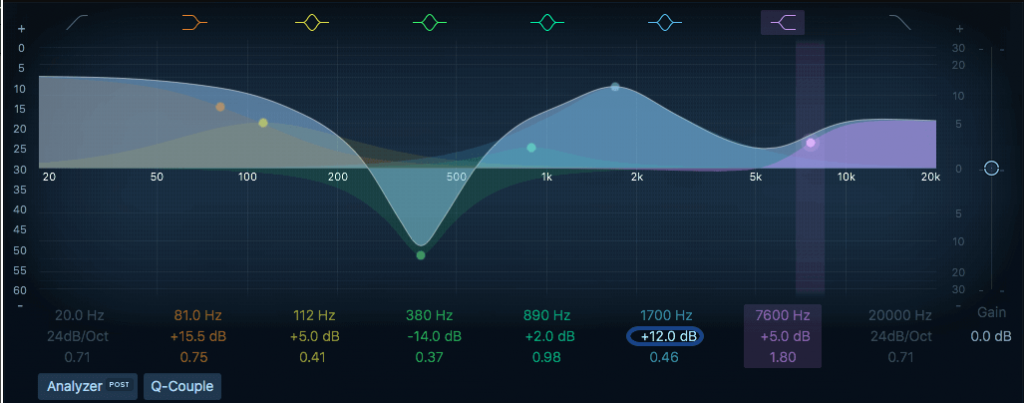What is an EQ? Why Do We Use Them in Music Production?
We use an equaliszer (EQ) to filter to islote specific frequency bands in a sound or mix and either cut, boost or leave them untouched. There are a vast array of EQ’s available, but they’re not just used in music production.
Consumer products such as home and car stereos, mobile phones and computers all have equalisers. But if you’re wondering what is an eq in music production, equipment such as guitar pedals and rack effects feature EQ’s, as well as digital software and mixing boards.
We use EQ’s to edit the tonal characteristics of the sound leaving the speakers. In music production, we can use an equaliser to make our listeners perceive sounds as closer in our mix by boosting the high end, or further away by rolling off the high and low end. We can use them to emphasise detail in a particular sound, or we can use EQ’s to isolate problematic frequencies in a sound or mix and, in some cases, surgically remove said frequencies.
Problematic frequencies can include a buzzing that came through when you were recording your guitar, or your mic picked up some outside rumbling that you don’t want in your recording. An EQ is your best friend in these situations.
But What Exactly Does an Equaliser Do?
An EQ is merely a tool that allows us to define and affect specific frequency bands. An equaliser can emphasise or cut specific frequencies with either linear or non-liner signal processing.
Most EQ’s use linear processing. This means that the signal leaving the EQ won’t change unless you apply a change in the EQ yourself. If you boost your mid frequencies between 1.2kHz and 2.4kHz, the signal leaving the EQ will sound boosted in these ranges.
Others, such as dynamic EQ’s, use non-linear processing. Non-linear processing means the EQ can apply changes to the signal based on instructions you’ve set. Dynamic EQ’s allow you to make the frequency bands/filters react to the incoming signal on their own but based on settings you’ve set with controls you’d find on a compressor like a ratio control, threshold, attack and release, etc.
If your final mixdown could do with punchier bass, an EQ could help you achieve this. By boosting somewhere between 20Hz to about 60Hz, you could make your bass pop. We say it could be a solution because the power of your bass also depends on how much you have going on in the low end of your song. Boosting these frequencies with too much going on in them, or just boosting these frequencies too much, will quickly muddy up your mix. This happens because our ears are less sensitive to sound than higher frequencies. Therefore, we can’t pick up on an individual element in low-frequency bands as well as we can in higher ones.
What is an EQ Band?
An EQ band is a group of frequencies that we can edit separately from the other frequencies of the input signal. Some EQ’s, like parametric and dynamic EQ’s, allow you to edit what frequencies are in each frequency band. Others, like graphic EQ’s, have predetermined frequency bands that you cannot edit.

In the image above, you can see Channel EQ. Channel EQ is the parametric EQ that comes with Logic.
Pay attention to the seven shapes at the top of the EQ. The middle five shapes that have colour are your EQ bands, while the grey slopes on the far left and right are high pass (left) and low pass (right) filters. We can use these two filter slopes to roll of high and/or low frequencies as we see fit.
The seven shapes have corresponding frequency and dB level information at the bottom of the plugin. You can see that low mid band, band 3, the dark green one, reads as “380 Hz” and -“14.0dB”. Under these two figures, you can also see a “0.37” figure.
To explain these figures, take a look at the big wavey line – a technical term. You can see that this particular band is dipped far below 0 on the (right) Y-axis, and sits just to the left of 500 on the X-axis. The Y-axis is dB level, while the X-axis is frequency range.
Now take another look at the bottom figures. You can see that the top two figures represent the exact location of the green dot that sits below the dipped curve. The 0.37, on the other hand, represents the width of the dipped curve.
This dipped curve is your low mid EQ band, and the width is known as bandwidth.
With this in mind, “380 Hz” represents where in the frequency spectrum the band is sitting, “-14.0” represents how loud this band is in dB, and “0.37” how wide or narrow the band is. How wide or narrow the band is determine what frequencies that sit between the second and fourth band are included in the third band.
For an easy to follow guide to the entire frequency spectrum, and therefore a tool to understand how to mix your music, check out our article here!
Now, I’m sure you want to dive in right away and start testing out your new knowledge of EQ’s and how they work. For that, you need some sounds.
We at Mixxed work with a growing number of sample labels and contributors to provide you with an affordable sample subscription service that’s more accessible than any before.
You’ll have access to our growing catalogue of thousands of loops, one-shots and sound effects that you can browse, download and keep forever for less than $3 a month.
Sign up today to find your sound!
